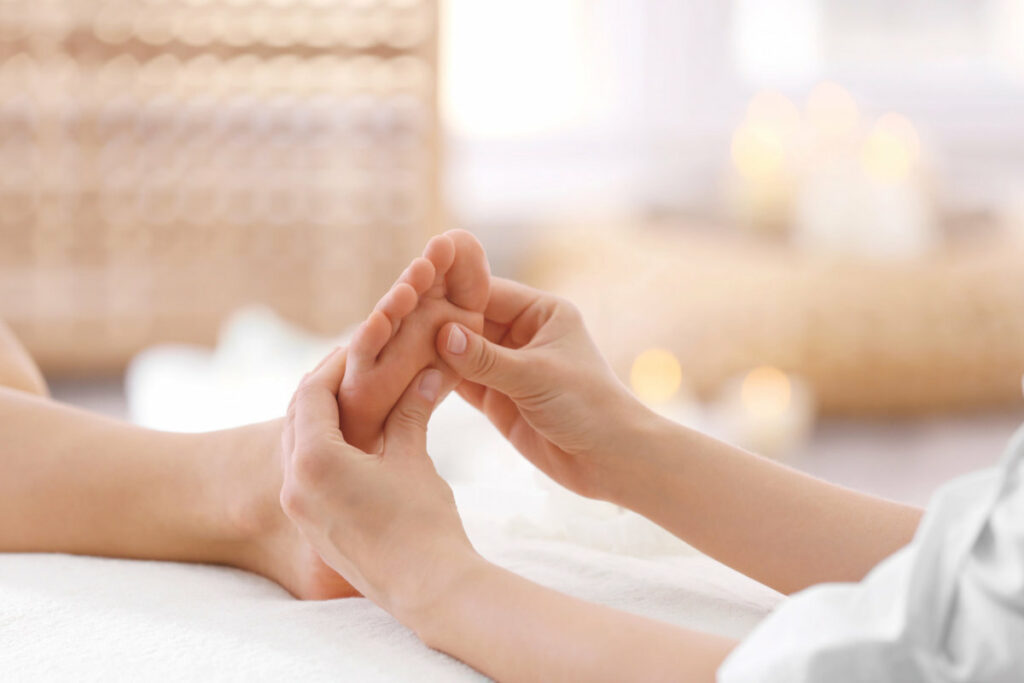Insomnia, or sleeplessness, is a common problem that affects many people. While there are various medical treatments available for insomnia, some people turn to complementary therapies like reflexology to help improve their sleep quality. Reflexology is a natural therapy that involves applying pressure to specific points on the feet and hands to promote relaxation and balance in the body. In this blog, we’ll explore the science behind reflexology for insomnia, the techniques and pressure points involved, and how it may be a beneficial complementary therapy for those experiencing sleep difficulties.
Contents
What Is Reflexology?
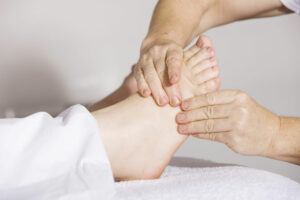 Reflexology is a type of alternative therapy that involves applying pressure to specific points on the feet, hands, and ears. It is based on the theory that these points correspond to different organs and systems in the body. By stimulating these points, reflexology aims to improve overall health and promote relaxation. It is often used as a complementary therapy for various conditions, including anxiety, stress, and pain management.
Reflexology is a type of alternative therapy that involves applying pressure to specific points on the feet, hands, and ears. It is based on the theory that these points correspond to different organs and systems in the body. By stimulating these points, reflexology aims to improve overall health and promote relaxation. It is often used as a complementary therapy for various conditions, including anxiety, stress, and pain management.
Is Reflexology Effective For Insomnia?
While there is some anecdotal evidence to suggest that reflexology may be helpful for insomnia, more rigorous scientific studies are needed to determine its effectiveness. Some small studies have shown promising results, but larger, high-quality studies are necessary to confirm these findings. That being said, reflexology may still be worth exploring as a complementary therapy for insomnia, especially for those who prefer non-pharmaceutical approaches to sleep management. As always, it is important to discuss any complementary therapies with your healthcare provider before trying them, especially if you have a medical condition or take medication.
Techniques Involved In Reflexology For Insomnia
Several techniques in reflexology for insomnia target specific reflex points on the feet or hands corresponding to sleep-promoting systems. Here are some common techniques in reflexology for insomnia:
Thumb walking
This technique involves using the thumb to apply pressure to specific reflex points on the feet or hands. The reflexologist may use a walking motion, moving the thumb up and down or side to side over the reflex points. Thumb walking is a common and effective technique used in reflexology, as it can help to stimulate multiple reflex points in a single session. The reflexologist may use different amounts of pressure depending on the sensitivity of the reflex point and the individual needs of the client.
Finger rotation
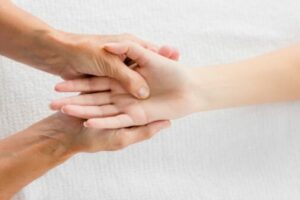 This technique involves using the fingers to rotate and massage specific reflex points on the feet or hands. The reflexologist may use circular or back-and-forth motions and may vary the amount of pressure applied depending on the individual needs of the client. Finger rotation can help to release tension and promote relaxation, as well as stimulate circulation and the body’s natural healing processes.
This technique involves using the fingers to rotate and massage specific reflex points on the feet or hands. The reflexologist may use circular or back-and-forth motions and may vary the amount of pressure applied depending on the individual needs of the client. Finger rotation can help to release tension and promote relaxation, as well as stimulate circulation and the body’s natural healing processes.
Hook and back-up
This technique involves using the fingers to hook around a specific reflex point, then pulling back and releasing the pressure. The reflexologist may repeat this process several times to help release tension and stimulate the reflex point. Hook and backup can be powerful techniques for breaking up congestion and stimulating the body’s natural healing processes.
Finger press and hold
This technique involves using the fingers to apply deep, sustained pressure to specific reflex points on the feet or hands. The reflexologist may hold the pressure for several seconds, then release and move on to the next reflex point. Finger press and hold can be a powerful technique for releasing tension and promoting relaxation, as well as stimulating circulation and the body’s natural healing processes.
Thumb and finger press
This technique involves using the thumb and fingers together to apply pressure to specific reflex points on the feet or hands. The reflexologist may use a combination of thumb walking, finger rotation, and finger press and hold to stimulate multiple reflex points during the session. Thumb and finger presses can be an effective technique for targeting specific reflex points and promoting relaxation and healing.
Hand and foot reflexology
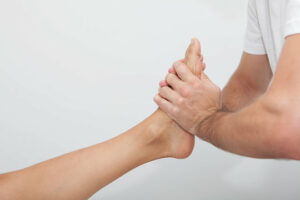 Depending on the individual’s needs, reflexology may be performed on both the feet and hands. Hand reflexology can be especially helpful for those who have difficulty sitting or lying down for extended periods, or for those who have foot or ankle injuries or sensitivities. The techniques in hand reflexology are similar to those in foot reflexology. However, these adapt to the smaller size and shape of the hands.
Depending on the individual’s needs, reflexology may be performed on both the feet and hands. Hand reflexology can be especially helpful for those who have difficulty sitting or lying down for extended periods, or for those who have foot or ankle injuries or sensitivities. The techniques in hand reflexology are similar to those in foot reflexology. However, these adapt to the smaller size and shape of the hands.
Pressure Points For Insomnia
There are several pressure points that reflexologists may focus on when performing reflexology for insomnia. Here are some of the most common pressure points:
- Pineal gland: Located in the center of the brain, the pineal gland produces the hormone melatonin, which helps regulate sleep-wake cycles. The reflex point for the pineal gland is located in the center of the big toe.
- Pituitary gland: The pituitary gland is often called the “master gland” because it controls the release of hormones that regulate many bodily functions, including sleep. The reflex point for the pituitary gland is located in the center of the pad of the big toe.
- Solar plexus: The solar plexus is a complex network of nerves in the abdomen. It is often associated with stress and anxiety. Stimulating the reflex point for the solar plexus, which is located just below the ball of the foot, can help promote relaxation and reduce stress.
- Adrenal glands: The adrenal glands produce hormones that help regulate the body’s response to stress. The reflex points for the adrenal glands are located just below the base of the toes, on the top of the foot.
- Spine: The spine is the body’s main communication pathway between the brain and the rest of the body. Stimulating the reflex points for the spine, which are located along the inside edge of the foot, can help promote relaxation and balance in the body.
Why Reflexology For Insomnia?
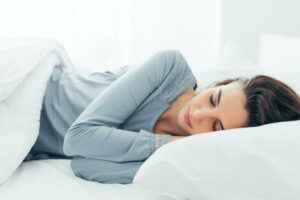 Reflexology for insomnia may be a beneficial complementary therapy for those experiencing sleep difficulties for several reasons:
Reflexology for insomnia may be a beneficial complementary therapy for those experiencing sleep difficulties for several reasons:
- Non-invasive: Reflexology is a non-invasive therapy that does not involve the use of drugs or other invasive treatments. It is a safe and natural way to promote relaxation and balance in the body, which can be beneficial for those experiencing insomnia.
- Holistic approach: Reflexology takes a holistic approach to health and wellness, meaning that it focuses on the whole person rather than just the symptoms. By stimulating specific pressure points on the feet and hands, reflexology can help to balance the body’s energy and promote overall wellness, which can be beneficial for those experiencing sleep difficulties.
- Stress reduction: Stress is a common contributing factor to insomnia, and reflexology may help to reduce stress levels in the body. By promoting relaxation and activating the parasympathetic nervous system, reflexology can help to reduce stress and promote a sense of calm, which can be helpful for those experiencing sleep difficulties.
- Natural approach: Reflexology is a natural approach to health and wellness that does not involve the use of drugs or other synthetic treatments. It can be a helpful complement to traditional medical treatments for insomnia. Moreover, it can be a natural way to promote restful sleep.
Overall, reflexology for insomnia may be a beneficial therapy for those looking for a natural, holistic approach to sleep difficulties. It can help to promote relaxation, reduce stress, and balance the body’s energy, which can contribute to better sleep quality and overall wellness.
Conclusion
In conclusion, reflexology may be a helpful complementary therapy for those experiencing insomnia. By stimulating specific pressure points on the feet and hands, reflexology can promote relaxation, reduce stress, and balance the body’s energy, which can contribute to better sleep quality and overall wellness. While more research is needed to fully understand the science behind reflexology for insomnia, many people have reported benefits from this natural, non-invasive therapy. If you’re struggling with sleep difficulties, consider giving reflexology a try as a natural and holistic approach to improving your sleep.
For more information, please contact MantraCare. Sleep is an essential part of our daily routine and it plays a significant role in maintaining a healthy body and mind. If you have any queries regarding Online Insomnia Counseling experienced therapists at MantraCare can help: Book a trial therapy session.
